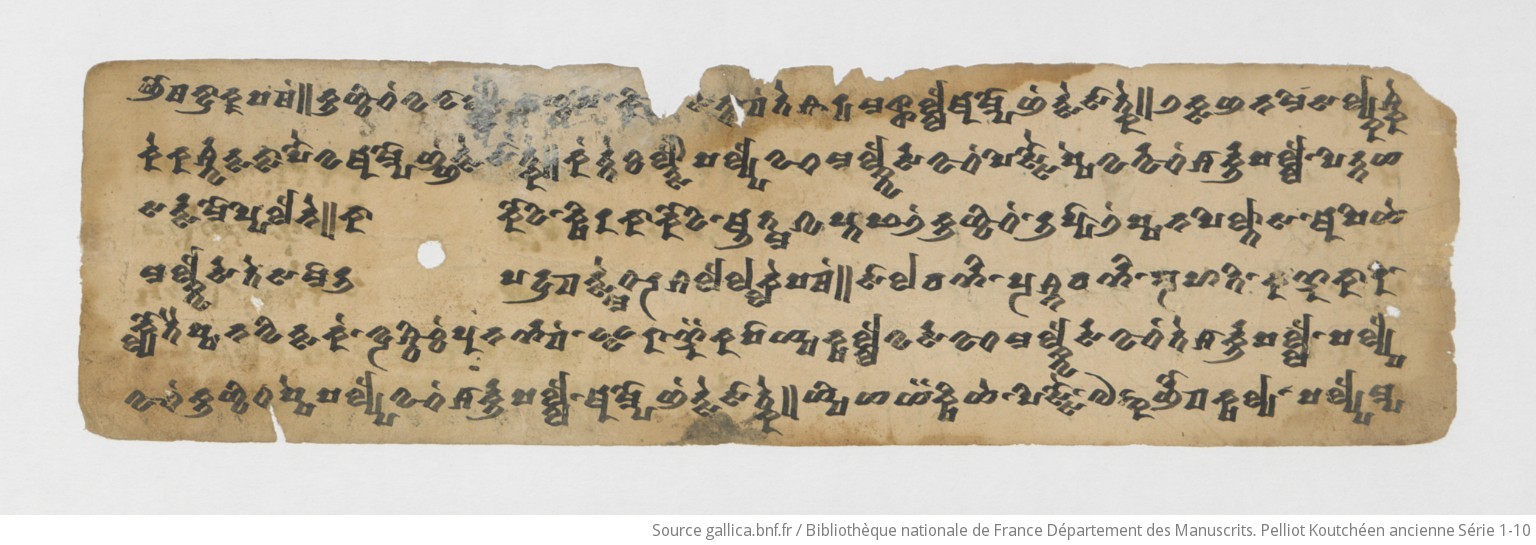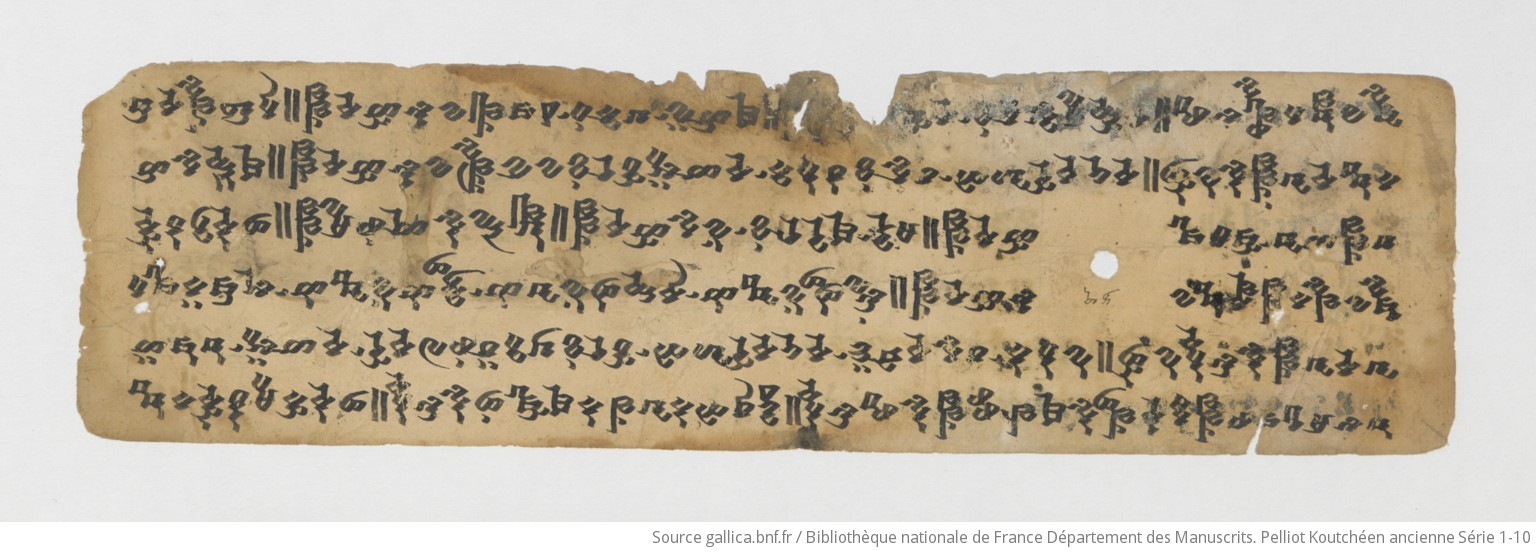Work in progress
PK AS 3A
| Known as: | PK AS 3A; Pelliot Koutchéen Ancienne Série 3A; P 1 |
|---|
| Cite this page as: | Georges-Jean Pinault; Melanie Malzahn (collaborator); Michaël Peyrot (collaborator). "PK AS 3A". In A Comprehensive Edition of Tocharian Manuscripts (CEToM). Created and maintained by Melanie Malzahn, Martin Braun, Hannes A. Fellner, and Bernhard Koller. https://cetom.univie.ac.at/?m-pkas3a (accessed 05 Jul. 2025). |
|---|
Edition |
| Editor: | Georges-Jean Pinault; Melanie Malzahn (collaborator); Michaël Peyrot (collaborator) |
|---|
| Date of online publication: | 2014-02 |
|---|
Provenience |
| Main find spot: | Dunhuang |
|---|
| Expedition code: | 3510, 49 |
|---|
| Collection: | Bibliothèque nationale de France, fonds Pelliot Koutchéen (Paris) |
|---|
Language and Script |
| Language: | TB |
|---|
| Linguistic stage: | classical |
|---|
| Add. linguistic characteristics: | late |
|---|
| Script: | classical |
|---|
Text contents |
| Text genre: | Literary |
|---|
| Text subgenre: | Medicine/Magic |
|---|
| Verse/Prose: | prose |
|---|
Object |
| Manuscript: | PK AS 3 |
|---|
| Material: |
ink
on paper |
|---|
| Form: | Poṭhī |
|---|
| Size (h × w): | 8.7 × 31.5 cm |
|---|
| Number of lines: | 6 |
|---|
| Interline spacing: | 1.4 cm |
|---|
Images
Transliteration
| a1 | ño ma ndrā kka ṣa maṃ || ku ñci¯ ¯t• wa wā l[ts]au • śā ñca po • ki¯ (–) s[i] ntā¯ ¯p• te śā rya ma s̝s̝a lle a mpo ñaṃ tse sā tke || la ksa ña na mi sa lyka śke |
|---|
| a2 | ke ka rśwa tsa tsā pau wa a mpo ññaṃ tse sā[ṃ] tke || kaṃ nte ka ltsau ṣa lype wa¯ ¯t ma lkwe rsa wa¯ ¯t• pi ssau ṣṣe wa rwa¯ ¯t• śā rku ṣa lle • pi tta ya |
|---|
| a3 | sa rtsa mo ppi le ne || kā ○ ko ṭi • kṣi ra kā ko ṭi • ā tma gu pta pha¯ ¯l• ku ñci¯ ¯t• • u ppā¯ ¯l• ṣṣa na pi ltā sa • a ṣi ye |
|---|
| a4 | ma lkwe rsa te sa mā u ○ pa dra¯ ¯p tsme ta¯ ¯r śa le la kle ṣa maṃ || sā la va rṇi • pra śna va rṇi • bra ha ti • ka ṇḍa kā ri • |
|---|
| a5 | klyo tai ṣṣa na wi tsa kaṃ • wra ści¯ ¯k• pu na rṇa¯ ¯p• • i rā¯ ¯ṇḍä ka ṣā ypa kṣa lle wa rsa wa¯ ¯t ma lkwe rsa wa¯ ¯t• te śā rku ṣa lle • ṣa lype |
|---|
| a6 | wa¯ ¯t• ku ñci ta ṣṣe ṣa lype wa¯ ¯t• śā rku ṣa lle • a mpo ñaṃ tse sā tke || ypi ya yä kṣi ye • pi ssau • o ṅka rño pa kṣa lya • ṣa lype mpa |
|---|
| lf | 40 8 |
|---|
| b1 | ṣe sa śā rya ma s̝a lle tsa rke lñe tse a lā s̝s̝a lle tse s̝pa sā tke || dvi vra ṇi ne pi le ne a mpo ñaṃ tse sā tke || ña ke no śta rce kau na ṣṣe |
|---|
| b2 | pi ka pi lle tse sā tke we ñau || we te ne • va tsa ka bi¯ ¯jä • ka ṭu ka ro hi ṇi • co ra¯ ¯k• pra ti vä¯ ¯s̝• o ka ro • ka ya¯ ¯stä• • ṣe me yä |
|---|
| b3 | rmtsa wa ltsa na lle klu ṣṣ[e] wa ○ rsa yo ka lle || swāṃ ññe weṃ ṣṣi ye • kra ṅka ñe weṃ ṣi ye • kuñi ye weṃ ṣṣi ye • su mā nä mpa ta |
|---|
| b4 | ṣa lle ya ṣi • mo ta mpa ○ yo ka lle || śa ḍi • a ri rā¯ ¯k• • weṃ tsa yo ka lle || plye ṅwā tse yu¯ ¯s̝• śwa lle || ña ke tri ce kau |
|---|
| b5 | na ṣṣe ka pi lleṃ tse we ñau || ka ṭu ka ro hi ṇi • va tsa¯ ¯k• ve te ni • ka ya¯ ¯stä co ra¯ ¯k• wa wā ltsau wa rsa yo ka lle || a ṅkai nsa yā |
|---|
| b6 | mtsi ai ṣle ta lptsi sa s̝pa || [k]a ṅko • [c]wa ssi [tsa]¯ ¯[k]• • ka [p]o (–) – – [l]·[e] || a yā¯ ¯wä • pa ni¯ ¯t• • e ma lye wa rsa yo ka lle || tra phā ltse ka ṣā |
|---|
Transcription
Translation
| a1 | ... just so the abscess sits down [= goes away]. Crushed sesame, Dalbergia sisu Roxb. [and] ... rock salt: this has to be put over [it] as a remedy against abscess. Fish meat finely |
|---|
| a2 | chopped [and] crushed [is] a remedy against abscess. Oil pressed a hundred [times] or [oil] with milk or aneth water has to be poured over [it], in case of a gall [boil], |
|---|
| a3 | a blood [boil], or a ulcer [lit. growth] boil. With Roscoea procera, Lilium polyphyllum, fruit of the Mucuna prurita, sesame, lotus leaves [or] goat |
|---|
| a4 | milk – with this, the sudden [outbreak of an] illness does not grow and together with it the pain sits down [= goes away]. Desmodium gangeticum, Uraria lagopoides, Solanum indicum, Solanum xanthocarpum, |
|---|
| a5 | roots of Tribulus terrestris, [two varieties of] Boerhaavia diffusa L., ricinus – the infusion is to be cooked either with water or with milk [and] this [is] to be poured over [it]; either oil |
|---|
| a6 | or sesame oil [is] to be poured over [it] – as a remedy against abscess. Barley flour, aneth and porridge [are] to be cooked, together with oil |
|---|
| b1 | [it] has to be poured over [it] as a remedy against inflammation and sickness. In case of the [two kinds of] wounds [and in case of a] boil, [this is] a remedy against abscess. But now I will tell the remedy |
|---|
| b2 | against the fourth day fever. Trigonella foenum graecum L., the grain of Holarrhena antidysenterica, Helleborus niger, Trigonella corniculata, Aconitum heterophyllum, Acorus calamus, cardamoms: |
|---|
| b3 | by one measure [this is] to be crushed [and] drunk with rice water. Pig excrement, chicken excrement, dog excrement: with jasmine |
|---|
| b4 | [this is] to be [made] set for the night [and] to be drunk with [fermented] wine. Trigonella foenum graecum, Terminalia chebula: [it is] to be drunk with urine. Plyeṅkwātse broth [is] to be eaten. Now I will tell [the remedy] |
|---|
| b5 | against the third day fever. Helleborus niger, Holarrhena antidysenterica, Trigonella foenum graecum, cardamoms, Trigonella corniculata: [this is] to be crushed [and] drunk with water. |
|---|
| b6 | [It is] to be given to cause vomiting and purging. Panic seed (?) ... [is to] be (drunk?), ... syrup is to be drunk with hot water. A decoction of the three myrobalans ... |
|---|
Other
| a4 | Zugleich vergeht [wtl. setzt sich] das Leiden. (Schmidt 1974: 74) |
|---|
| b1+ | Now I will state the remedy of a fever of the fourth day. (Peyrot 2013b: 656) |
|---|
| b4+ | No I will state [the remedy] of a fever of the third day. (Peyrot 2013b: 657) |
|---|
Commentary
Linguistic commentary
| * | The text has some late features: sātke for sāṃtke (several times); witsakaṃ (a5); aṅkainsa for aṅkaintsa (b5). |
|---|
| n1 | uppāl\•ṣṣana: Note the virāma stroke separating the adjective suffix. |
|---|
Remarks
| * | A complete leaf; the leaf number is written inside the string hole space. |
|---|
Philological commentary
| n2 | Filliozat read vitsakabij, but the manuscript clearly has vatsakabij, unless one assumes that the vowel had been completely erased (which does not seem very likely given the good preservation of the fragment). |
|---|
| n3 | One has to read motämpa not mautämpa (the blotch above the sign is not a correction mark). |
|---|
| n4 | The correct reading is [k]aṅko, because the third blotch upon the sign cannot belong to an 〈au〉 to be judged by other clear instances of 〈au〉 in the same manuscript. |
|---|
| n5 | In the lacuna the last akṣara l·e is quite certain; before one may see a trace of an e-vowel, so that a restoration (y)[o](ka)l(l)[e] is possible. If this is correct, we expect a perlative before the gerund. One can read kapo, kaṣo, or kapho. A kapo(tsa) may be a borrowing of Skt. kāpota- 'antimony, natron'. As for [tsak]\, the first sign is very unclear while the k is quite certain. |
|---|
References
Edition and translation
Filliozat 1948: 49-51; Sieg and Thomas 1954: 67-68
Translations
Peyrot 2013b: b1 b2 (656), b4 b5 (657); Schmidt 1974: a4 (74)
Bibliography
Filliozat 1948
Filliozat, Jean. 1948. Fragments de textes koutchéens de médecine et de magie. Texte, parallèles sanskrits et tibétains, traduction et glossaire. Paris: Librairie d’Amérique et d’Orient Adrien-Maisonneuve.
Peyrot 2013b
Peyrot, Michaël. 2013b. The Tocharian subjunctive. A study in syntax and verbal stem formation. Vol. 8. Brill’s Studies in Indo-European Languages & Linguistics. Leiden/Boston: Brill.
Schmidt 1974
Schmidt, Klaus T. 1974. “Die Gebrauchsweisen des Mediums im Tocharischen.” PhD, Universität Göttingen.
Sieg and Thomas 1954
Sieg, Emil, and Werner Thomas. 1954. “Die medizinischen und tantrischen Texte der Pariser Sammlung in Tocharisch B.” Zeitschrift für Vergleichende Sprachforschung 72: 63–83.




